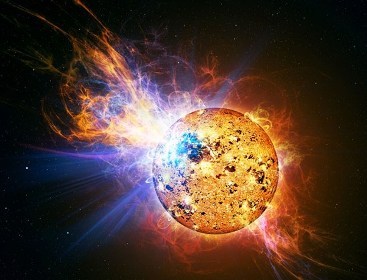 |
(Casey Reed/NASA) |
An international team of astronomers says they've seen the first evidence of a planet's destruction as its aging star became a red giant at the end of its life.
"A similar fate may await the inner planets in our solar system, when the sun becomes a red giant and expands all the way out to Earth's orbit some 5 billion years from now," team member Alex Wolszczan, a professor of astronomy and astrophysics at Penn State University, said.
Wolszczan and his international colleagues detected evidence of the missing planet's destruction while studying the aging star and searching for planets around it.
The evidence includes the star's peculiar chemical composition, and the highly unusual elliptical orbit of its one surviving planet, a Penn State release said Monday.
"Our detailed spectroscopic analysis reveals that this red-giant star, BD+48 740, contains an abnormally high amount of lithium, a rare element created primarily during the Big Bang 14 billion years ago," team member Monika Adamow said.
Lithium is easily destroyed in stars, which is why its abnormally high abundance in this older star is so unusual, the astronomers said.
"In the case of BD+48 740, it is probable that the lithium production was triggered by a mass the size of a planet that spiraled into the star and heated it up while the star was digesting it," Adamow said.
The highly elliptical orbit of the star's remaining planet is more evidence for a destroyed planet, astronomers said.
"Such orbits are uncommon in planetary systems around evolved stars and, in fact, the BD+48 740 planet's orbit is the most elliptical one detected so far."
Gravitational interactions between planets are normally responsible for such peculiar orbits, and the researchers say they believe the missing planet could have given the surviving massive planet a gravitational shove as it spiraled to its destruction, throwing the survivor planet into an eccentric orbit like a boomerang. (UPI)
<관련 한글 기사>
행성 집어삼키는 별, 그 현장 포착!
태양과 같은 항성이 적색거성이 되어서 주변의 행성을 파괴하는 과정에 대한 흔적이 포착되었다.
외신 보도에 따르면 미국의 펜실베니아 주립대학 등 여러 나라의 천문학자들이 공동으로 진행한 연구에서 적색거성 BD+48 740이 주변의 행성을 파괴한 것으로 보이는 흔적을 발견했다고 한다.
적색거성이란 태양과 같은 항성이 진화 과정 중 마지막 단계를 거치며 지름이 태양의 수십 배 내지 수천 배로 커지고 표면온도는 낮은 거대한 별이 되는 것을 뜻한다.
연구진이 BD+48 740이 주변의 행성을 집어삼켰다고 보고 있는 근거는 두 가지가 있는데, 하나는 BD+48 740 내부에서 관찰되는 다량의 리튬이다.
리튬은 140억년전 빅뱅이 일어났을 당시 만들어진 물질이라 추정되는데 항성 내에서는 쉽게 파괴되는 것으로 알려져 있다. 그러나 행성을 집어삼킨 별에서는 리튬이 쉽게 관측된다.
두 번째 증거는 ‘살아남은 행성의’ 심한 타원형 궤도이다.
연구진은 이 적색거성 주변에서 수평으로 매우 긴 타원형의 궤도를 가진 행성을 발견했다.
“이러한 궤도는 궤도는 항성계에서는 보기 드문 것입니다. 게다가 (발견된 행성의) 궤도는 지금까지 발견된 것 중 가장 심한 타원형이더군요”라고 연구진은 밝혔다.
이렇듯 특이한 궤도는 행성들 사이의 중력 작용의 결과인 경우가 대부분이다.
연구진은 적색거성에 의해 집어삼켜진 행성이 거성 안으로 빨려들어가면서 남아있는 행성을 중력으로 ‘밀었고’, 그 결과 이 행성이 마치 부메랑과 같은 긴 타원형의 궤도를 갖게 되었다고 추정하고 있다.
연구에 참여한 펜실베니아 대학 교수 알렉스 울잔은 “앞으로 50억년 뒤에 태양이 적색거성이 되어 지구의 궤도까지 팽창한다면 이러한 일이 태양계에서도 일어날 수 있다”고 설명했다.








![[Today’s K-pop] Blackpink’s Jennie, Lisa invited to Coachella as solo acts](http://res.heraldm.com/phpwas/restmb_idxmake.php?idx=644&simg=/content/image/2024/11/21/20241121050099_0.jpg)